- News
- Reviews
- Bikes
- Components
- Bar tape & grips
- Bottom brackets
- Brake & gear cables
- Brake & STI levers
- Brake pads & spares
- Brakes
- Cassettes & freewheels
- Chains
- Chainsets & chainrings
- Derailleurs - front
- Derailleurs - rear
- Forks
- Gear levers & shifters
- Groupsets
- Handlebars & extensions
- Headsets
- Hubs
- Inner tubes
- Pedals
- Quick releases & skewers
- Saddles
- Seatposts
- Stems
- Wheels
- Tyres
- Tubeless valves
- Accessories
- Accessories - misc
- Computer mounts
- Bags
- Bar ends
- Bike bags & cases
- Bottle cages
- Bottles
- Cameras
- Car racks
- Child seats
- Computers
- Glasses
- GPS units
- Helmets
- Lights - front
- Lights - rear
- Lights - sets
- Locks
- Mirrors
- Mudguards
- Racks
- Pumps & CO2 inflators
- Puncture kits
- Reflectives
- Smart watches
- Stands and racks
- Trailers
- Clothing
- Health, fitness and nutrition
- Tools and workshop
- Miscellaneous
- Buyers Guides
- Features
- Forum
- Recommends
- Podcast
BUYER'S GUIDE
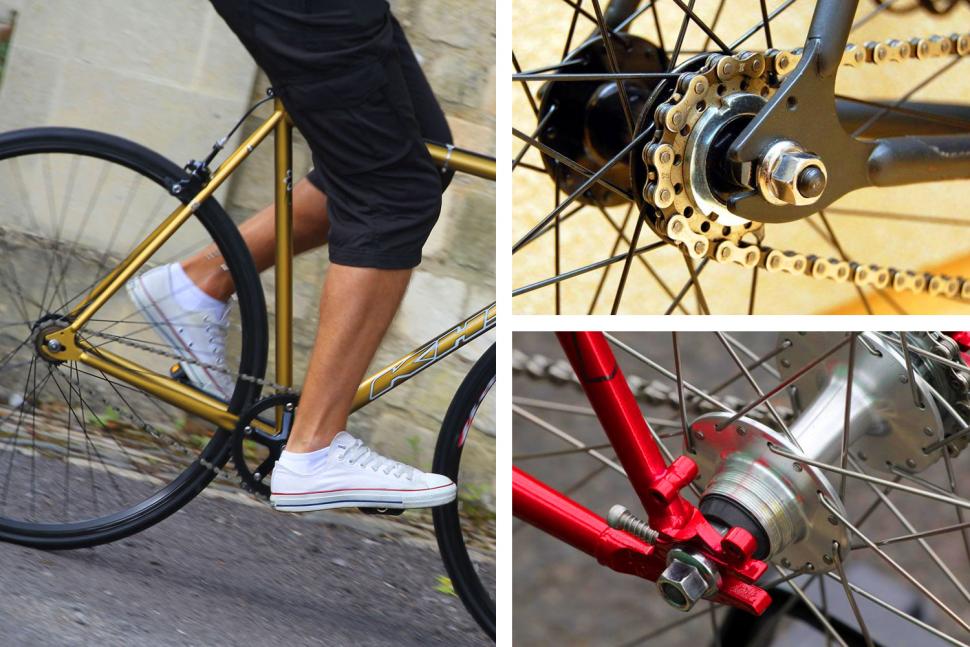 Why your next bike should be a fixie August 2018
Why your next bike should be a fixie August 2018What's a fixed-gear bike good for? Should you buy a fixie?
Variously known as fixed-wheel bikes, fixed-gear bikes or just fixies, these are bikes derived from the machines used for track racing on velodromes. Their key feature is that they have no freewheel mechanism, so if you're moving you have to pedal.
-
With no freewheel, a fixed-gear bike forces you to pedal all the time, which can help you stay fit during the winter and develop a fast, fluid pedalling action
-
The natural habitat of a fixed-gear bike is the velodrome where they're compulsory, and don't have brakes
-
To use a fixie on the road it must have at least a front brake, and a rear brake is a good idea
-
Because you can slow down a fixed-wheel bike by resisting pedal motion, they give a unique feeling of being intimately connected to the bike
-
With no gears or freewheel to go wrong, fixies are extremely reliable and a chain running in a straight line lasts ages
For a few brief months in about 2009 fixies were achingly trendy. But now the tragically hip have moved on, it’s time to reclaim the simplest bike style of all.
Almost all modern bikes have a freewheel, the ratcheting mechanism in the rear wheel that means you can stop pedalling and coast along. The earliest bikes were like modern fixies though, with just one gear ratio and no freewheel.
Today, the only place where fixies are common — compulsory, in fact — is in the velodrome, where the ‘keep it simple’ ethos of track racing demands a single gear and no brakes.
While they were trendy it seemed like fixies were everywhere, and large bike makers scrambled to add them to their ranges. But the hipsters rapidly discovered that a genuine fixed gear bike is not a trivial thing to ride, and flopped their wheels over to the freewheel on the other side.
That left fixies back with the riders who’ve treasured them for years: road cyclists who crave simplicity, and a handful of cycle couriers who love their almost-nothing-to-go-wrong character.
What’s a fixie anyway?
A road bike with, for our purposes, drop bars and a single fixed gear, and brakes. By law a bike on the road in the UK must have two brakes. Slowing the bike down by pushing against the pedals counts as a brake, but in an emergency you’re almost certainly going to forget that if you’ve been riding regular bikes for a few years. Best to stick with the stopping you’re used to.
Familiarity is the reason for sticking with drop bars too, but there’s another. A trendy ultra-narrow flat bar on a fixie marks you as someone too daft to realise you still can’t ride through a 12-inch gap because your shoulders or hips will get stuck. Just say no.
What’s a fixed-gear bike good for?
Traditionally, a fixie was the quintessential winter bike, for two reasons. You’re always pedalling if you’re riding a fixed-wheel bike, so the theory goes that you have to work all the time — no freewheeling means no slacking. Riding a fixie means you make the most of your limited winter riding time.
The other reason for riding fixed in the winter is that water and salt is not exactly good for bike parts made from steel and aluminium. Derailleurs and freewheel mechanisms are especially vulnerable, so it makes sense to do without them.
Modern derailleurs seem to be more weather-resistant than those of the 60s and 70s, and they’re substantially cheaper, so this is less of a problem than it once was. Nevertheless, a bike that doesn’t need much maintenance over the winter is appealing if you have to work on your bike in a cold garage or shed or outside on the patio.
Fixed-gear bikes make great winter bikes, but they’re also excellent urban rides, provided you don’t have to tackle any long, steep hills. The lack of shifters means there’s one fewer distraction, and the ability to control your speed directly through the transmission gives you a useful extra degree of control.
Learning to ride a fixie takes time though. I’d been using a fixie to commute for a few days when I had probably the stupidest crash of my life. Approaching a red light I stood up to coast to a halt, ready to track-stand. Well, you can’t coast to a halt on a fixie, and as I straightened my knees the bike spat me down the road on my arse.
Fortunately it was wet, so I slid along the road without leaving too much skin behind, and there was nothing motorised behind me. A salutary lesson, though, and a mistake I didn’t make again.
The philosophy bit
The real joy of riding a fixie is the feeling of direct connection with the bike. Yes, I know fixie enthusiasts tend to wax evangelical about this, but that’s for a good reason: it’s true.
There’s something almost mystical about being intimately connected to the transmission and rear wheel on a fixie. You’re physically engaged with the bike in a way that just doesn’t happen with a freewheel. That unavoidable pedalling imperative focuses your attention on staying smooth and fluid, especially as your speed increases. You can’t afford to be choppy if you’re doing 25mph in a 65-inch gear.
It’s debatable whether developing a smooth pedal stroke is an aim worth pursuing in itself, but if it’s important to you, riding a fixie is a great way to get smooth.
Three classic fixies
There’s a school of thought that says the greatest road-going fixies start life as classic steel road bikes with horizontal dropouts, found on eBay, Gumtree or the dusty backrooms of long-established bike shops, or as similarly vintaged track frames with brakes added. But if you don’t have the time and patience to find a vintage frame to build up, there are plenty of brands that will sell you a fixie that’s ready to roll, or a modern road-going fixie frame. To give you a taster, here are three of them.
BLB City Classic — £599
London's Brick Lane Bikes has long been a driver of UK fixie culture. Their own-brand fixie has a double-butted chromoly steel frame and a handsome parts selection in mostly plain aluminium for a classic look.
All-City Thunderdome — £1,000 (frame & fork)
You'll have to build it up yourself — or get a shop to do so — but the reward is bike with a fearsome reputation in the fixie and singlespeed underground. Made from All-City's own Alumisonic tubing to keep the weight down and the stiffness up, it features thoughtful details like stainless steel inserts in the drop-outs and All-City's own tidy seatpost clamp.
Cinelli Tutto Plus Pista — £1,199.00
One of the more eccentric bikes to come out of Cinelli — whose bikes are always a bit entertainingly off-beat — the Tutto Plus Pista can be a fixie, or a singlespeed or a geared road bike, and the frame has room for tyres up to 45mm wide for gravel or pothole-bashing.
Cafe wisdom: road.cc readers weigh in on fixies
Our readers are always a great source of information. Here's the pick of what they had to say about fixed-wheel bikes in the previous version of this article.
BarryBianchi: "Ridden one for years. They are a pain in the arse when:
"You go uphill much
You go downhill much
You get a big headwind
You get a big tailwind
You are tired
You ran too far the day before
You try to cycle at someone else's pace
You have to carry a heavy load
Your achingly ironic facial hair blows in your face.
"But they are fun when all that doesn't happen, and the silence is nice."
doodlydiddle: "Love my fixed gear bike. All steel frame and forks, lovely smooth and quiet ride. Perfect for winter training and commuting. I think I enjoy riding this bike the most out of the ones I own.
"I understand it isn't for everyone, but I've never struggled with my knees through riding one. I typically ride a 72" or 75" gear, and can attain 36mph downhill before it becomes a struggle to stay on top of the gear. Uphill is not too difficult, it just requires determination.
"It is really good fun to ride, requires very little maintenance (I do run brakes front and rear on mine) and the chain lasts 2-3x the miles that the chains on my geared bikes do."
wycombewheeler: "I always thought fixed gear bikes were for masochists that were into self harm, but couldn't afford to show scars."
sneakerfrfeak: "I've been riding a Dolan FXE fixed for the last three winters and strangely look forward to digging it out of the garage again each year around October. Running a 48X19 which gives around 20mph at 105 cad, you do have to choose your routes a little more carefully though. Love the simplicity and near silence from the drivetrain. At first it felt like it was turning my legs down steep descents instead of me turning the pedals, but after a while you get the confidence to just let your legs go and get on top of the gear, maxed out at 184 cad down one local descent. I originally built it after getting fed up of replacing chain, bb, freehub etc. after every winter on my summer bike.
"Would def recommend the Dolan FXE for anyone tempted to go down the fixed route, I picked the frame-set up for around £200 and built it up as I already had other parts kicking around the garage, you can pick up the complete bike for around £750 with a pretty decent spec."
cyclisto: "I had bought a used SS/Fixed bike at less than half its RRP which I rode as a single speed. It was very, very, very beautiful but akward to ride. With its skinny tires and no name caliper brakes, it just couldn't brake and a single speed bike is not enough on uphill and downhill. When I bought it the previous owner had done less than 100 miles judging from its immaculate condition and I did even less. Hopefully the 3rd owner will ride it more."
s_lim: "I've a Gazetta in a very lovely red, and have been commuting/training/club riding on it for years; even raced a club crit on it.
"I love it - the simplicity of it just appeals to me. I ride it freewheel, for as much as I enjoy climbing, fixed just doesn't let you enjoy a long descent. Change the chain and the freewheel every few months, and you're good to go. I ride it 48/16 which is more than capable of coping with most terrain. It's genuinely my favourite bike, and wouldn't swap it for the world."
Farr: "I ride a fixie (I'll call it what I want) round London and I love it. Commuting on a road bike isn't the same anymore. I started off buying a single speed then when that was ready for an upgrade, went fixed (although I could have just swapped the wheel on the first bike) for my new bike and haven't looked back. It's got a front brake and narrow bull-horn bars. You know the type.
"A new chain and a pair of pads every year is all it needs. I've had schwalbe durano plus on it for about 3 years and they're still going. 23s though, I'll go for 25s when they wear out.
"Had a few moments when my thigh bones appeared to be trying to escape through my armpits when I first started, but you get used to not being able to coast quickly. Helps with leg muscles and getting used to pedalling smoothly, or at least in my case. I had visions of riding MashSF style, skid stopping at high speed between traffic. That doesn't happen, I just use the brake."
sea-level: "I started riding fixed for my commute in Brighton last October, and am so glad that I did. Previously I could just freewheel down the hill into work in the morning, with barely a turn of the pedal, and riding fixed forces me to spin, which is good. And somehow, riding fixed is just fun - especially in the urban environment.
"Some things I have found out:-
- Sheldon Brown was a real fixie enthusiast, and his website has a lot of great material on riding fixed.
- It's best to practice at the local park or track before going anywhere near a road.
- Foot retention - so many web articles stress the importance of using foot retention when riding fixed, and I have found that it is so. I ride with normal everyday shoes, and so use special pedals ("Stolen Thermalite") combined with foot retention straps ("Hold Fast").
- Brakes - I'll stick with my front and back caliper brakes, thanks. When you're at speed, the fixie is a beast of momentum, and resisting the motion of the pedals seems ludicrous and I'm not going to try it. Hence the brakes.
- The one and only gear - worth getting right for your riding environment. My fixie came with 46 / 16T, but that proved a little too tough for the stop-start of Brighton's North Laine... my LBS swapped the 16 for an 18, which has proved to be just right.
- While it's true that you can fit no smaller than your shoulders (a point Emily Chappell makes in passing in her book on her courier days in London), I prefer riser handle bars of moderate width for both the look and the ride. I think they fit the fixie riding style better.
- Knees - my knees can get sore, and overall riding fixed has helped improve their strength, and reduced the soreness. But you've got to build up to it, and being overambitious on the steeper hills (and too soon) can lead to extra knee problems.
- Hills - if it's a steeper one, I'm happy to get off and push. There used to be a few places where I had to get off and push on my commute home, but this number has reduced over the last few months.
- The fear - the first time I rode fixed on the roads to work and back, I arrived home red in the face, shaking like a leaf, and swearing that I'd never do that again. But I persevered, and now ride around with happiness and confidence.
- Stock tyres - when I got my off-the-shelf fixie, the first thing my LBS did was ditch the flimsy-looking tyres and put on some decent, durable, puncture-resistant tyres (Continental Grand Sport Extra @ 25mm). I think it's a good and necessary investment.
- Chain tensioning - over time the chain will slacken, and there is the risk that it will jump off the front cog. It needs a bit of tightening every so often (but not too tight), and having some form of chain tensioner on the rear dropouts can make this really easy to do.
- After some months, riding fixed becomes an integral part of your riding life. I can't imagine being without it now."
themuffle: "I commuted into London - 10 miles in, 10 miles out on a road bike which gradually destroyed itself. Then I bought a Dolan Track Champion, changed the fork, stuck a front brake on. My legs got bigger every day. Not only did my legs get a workout getting up to Crystal Palace but they they got a workout going down the hill into Dulwich as well. Get one! There is of course the no maintenance bonuses as well..... I cannot recommed going fixed enough."
rix: "Why your next bike should be a fixie..."
a. You want to damage your knees.
b. You do not have knees.
c. You have plenty of spare knees."
Explore the complete archive of reviews of fixed and singlespeed bikes on road.cc
About road.cc Buyer's Guides
The aim of road.cc buyer's guides is to give you the most, authoritative, objective and up-to-date buying advice. We continuously update and republish our guides, checking prices, availability and looking for the best deals.
Our guides include links to websites where you can buy the featured products. Like most sites we make a small amount of money if you buy something after clicking on one of those links. We want you to be happy with what you buy, so we only include a product if we think it's one of the best of its kind.
As far as possible that means recommending equipment that we have actually reviewed, but we also include products that are popular, highly-regarded benchmarks in their categories.
Here's some more information on how road.cc makes money.
You can also find further guides on our sister sites off.road.cc and ebiketips.
road.cc buyer's guides are maintained by the road.cc tech team. Email us with comments, corrections or queries.
John has been writing about bikes and cycling for over 30 years since discovering that people were mug enough to pay him for it rather than expecting him to do an honest day's work.
He was heavily involved in the mountain bike boom of the late 1980s as a racer, team manager and race promoter, and that led to writing for Mountain Biking UK magazine shortly after its inception. He got the gig by phoning up the editor and telling him the magazine was rubbish and he could do better. Rather than telling him to get lost, MBUK editor Tym Manley called John’s bluff and the rest is history.
Since then he has worked on MTB Pro magazine and was editor of Maximum Mountain Bike and Australian Mountain Bike magazines, before switching to the web in 2000 to work for CyclingNews.com. Along with road.cc founder Tony Farrelly, John was on the launch team for BikeRadar.com and subsequently became editor in chief of Future Publishing’s group of cycling magazines and websites, including Cycling Plus, MBUK, What Mountain Bike and Procycling.
John has also written for Cyclist magazine, edited the BikeMagic website and was founding editor of TotalWomensCycling.com before handing over to someone far more representative of the site's main audience.
He joined road.cc in 2013. He lives in Cambridge where the lack of hills is more than made up for by the headwinds.
Latest Comments
- David9694 17 min 33 sec ago
Stouport residents bemoan huge traffic queues through town...
- imajez 6 hours 22 min ago
- looks like someone has fallen for the steel is real markerting BS. I only care how a bike rides, not what it is made of. I had a lovely steel...
- lonpfrb 7 hours 42 min ago
That argument is ignorance of the widespread height and width restrictions to be found on the many minor roads that were originally created for...
- rookybiker 11 hours 11 min ago
The trailer seems to connect to both ends of the rear axle. Can it do tight corners without dragging the tyre sideways?
- froze 11 hours 14 min ago
Motorists have always been unkind to cyclists, but distracted driving is adding to the problem....
- Destroyer666 12 hours 7 min ago
Have you owned Bont shoes? In my experience even the widest Lake shoes have had a bizarre form of narrowing way too much in the toe area. But the...
- froze 12 hours 35 min ago
Not sure if this is possible, but this news letter goes out all over the world, and some places like Decathlon does not send stuff to America, in...
- Hirsute 13 hours 20 min ago
I'm confused as to why you'd need bib shorts indoors.
- Oldfatgit 13 hours 49 min ago
I'm sure you were being sarcastic... however ... Lewis Hamilton lives in Monaco. Yet another car driver that doesn't pay any tax
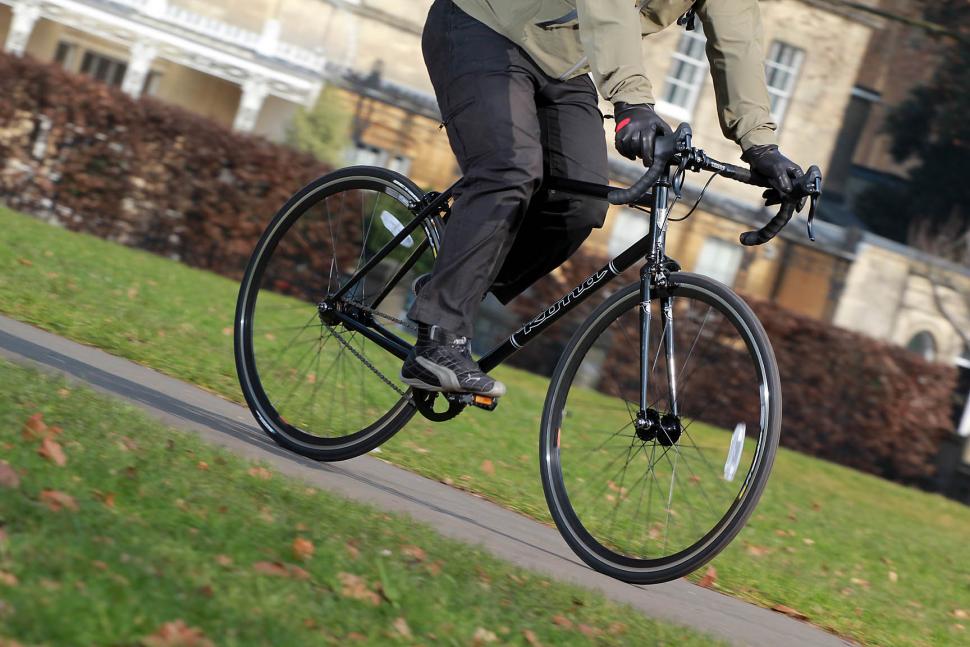

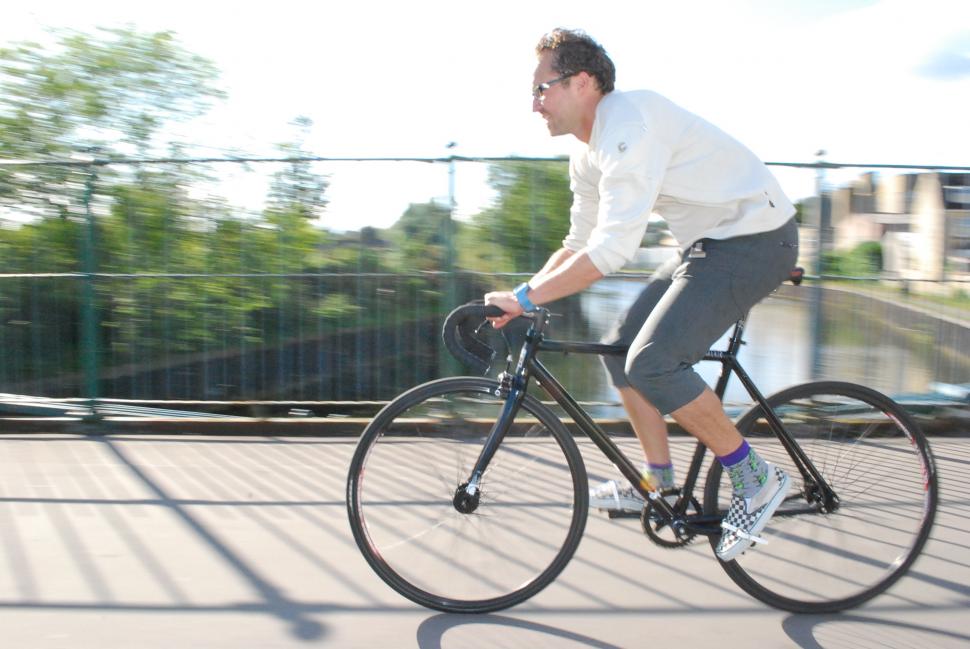
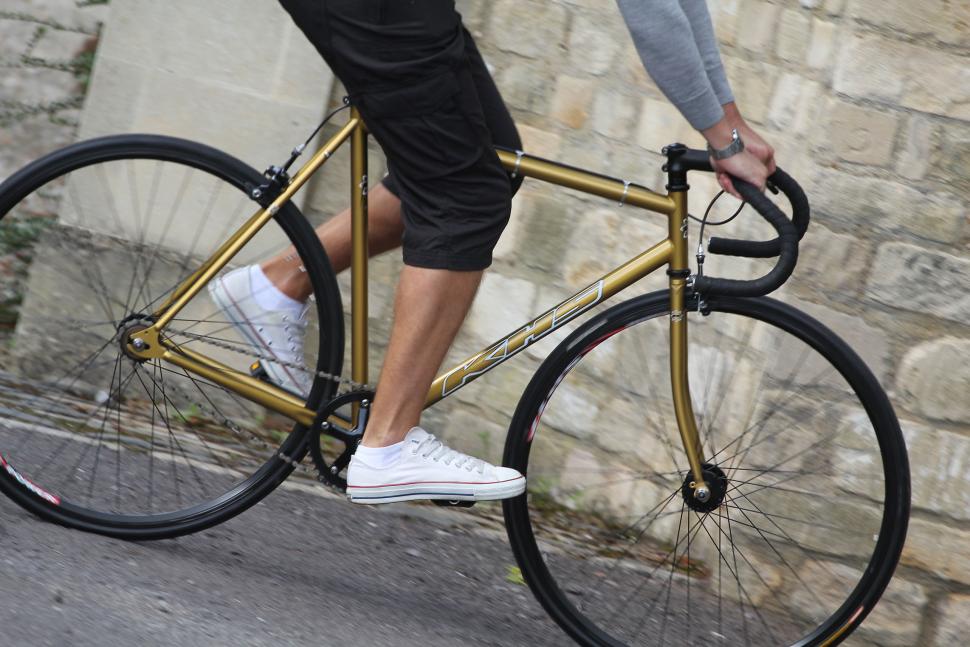

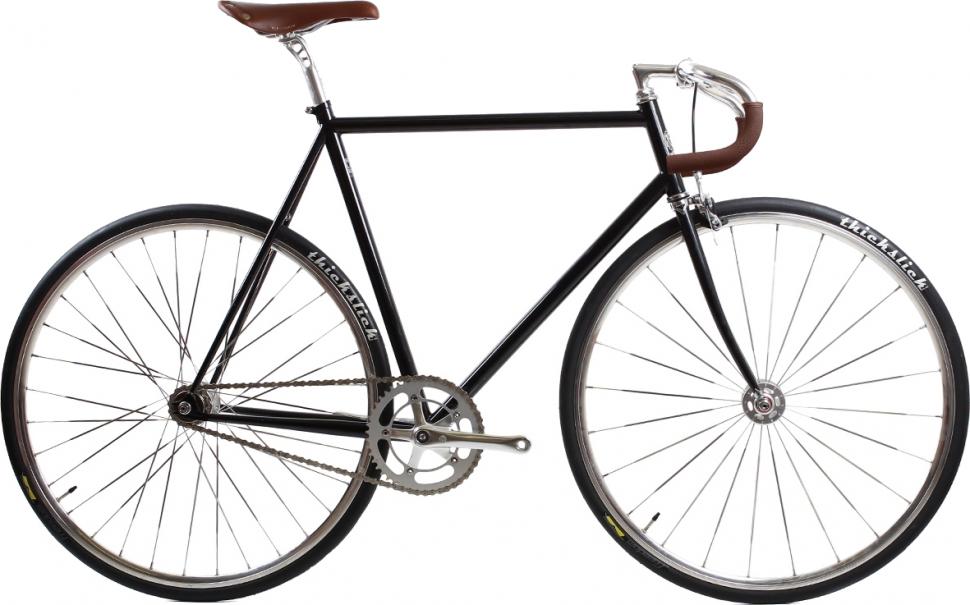
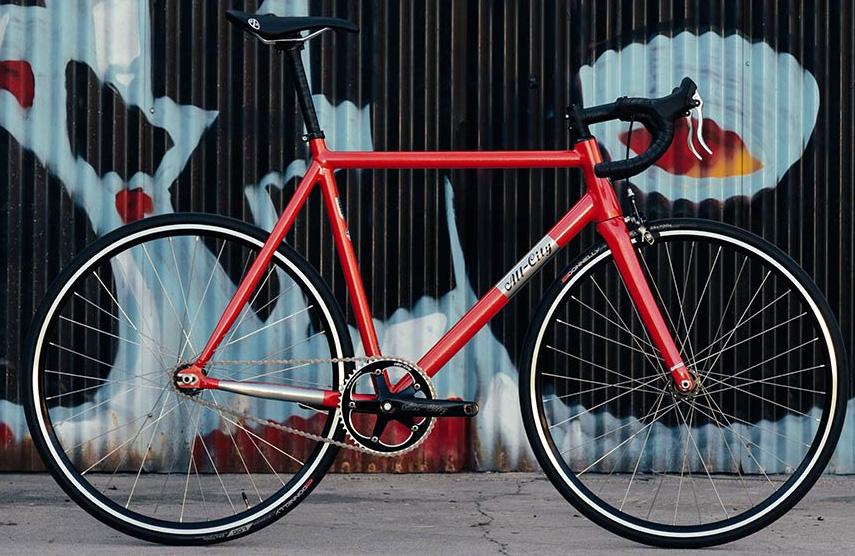

Add new comment
3 comments
Another (more or less pointless) rehash of an old article ?
I agree that brakeless fixies anywhere but the track are a seriously bad idea, but although I don't have the leg strength to stop using just pedal pressure, I find my fixed wheel bike is ideal choice in traffic, it's just so much easier for fine control of speed/maintaining safe distance behind vehicle in front/acceleration away from lights. And being built around a very ugly £50 ebay steel frame means the security worries are slightly reduced.
Keep them were they belong - on a velodrome!
Yes indeed, my youngest now has a single speed and keeps threatening to turn it into a fixie. I point out that when he rode one on the track, he did struggle.
I saw one idiot yesterday with a brakeless fixie. No you can't stop as quickly without a brake, get real.